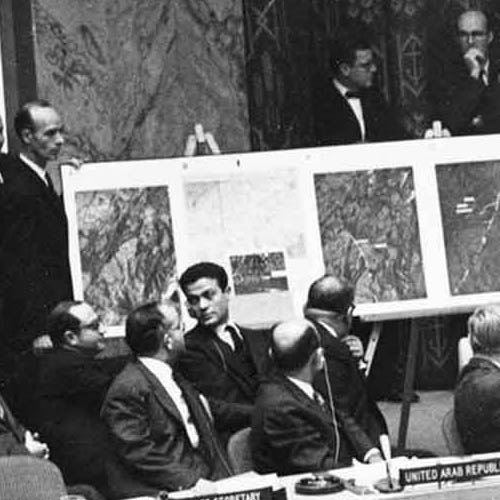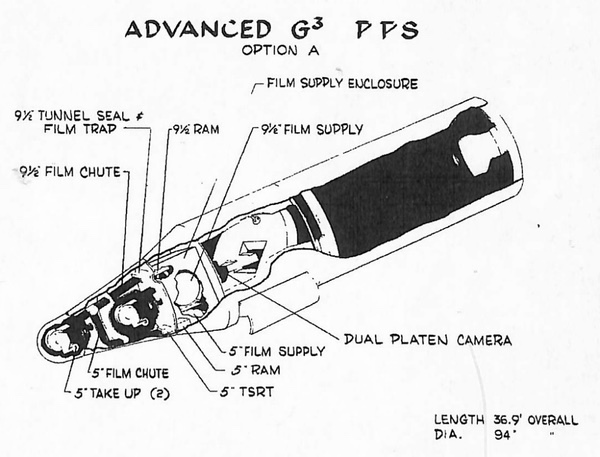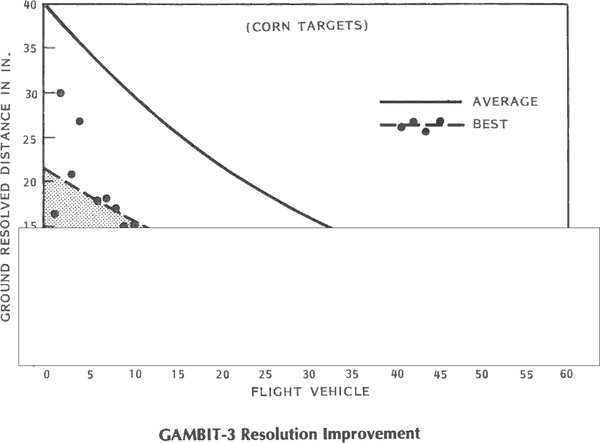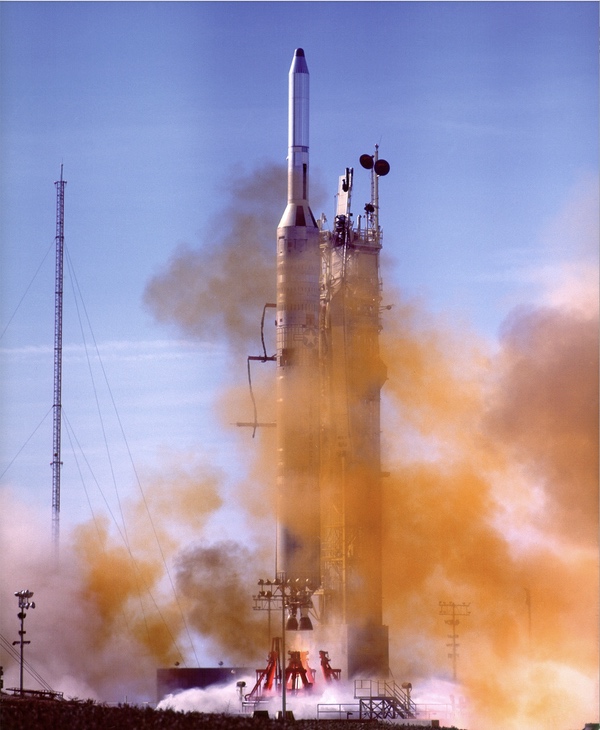GAMBIT vs KENNEN: The persistence of film reconnaissance in the digital ageby Dwayne A. Day
|
| The new information now sheds light on why, even after KENNEN entered service, the United States continued operating film-based reconnaissance satellites into the first half of the 1980s. |
Part of the explanation has been known for some time. In January 1993, the House Armed Services Committee produced a report about intelligence successes and failures in the recently completed Operations Desert Shield/Storm.[1] In the report, one unnamed military commander bemoaned the lack of a retired, but then still-classified satellite system that could have provided wide-area coverage of the battlefield. That system was the HEXAGON reconnaissance satellite, which could have imaged nearly all of Iraq in a single orbital pass over the country. The report further stated, “The absence of wide-area coverage has been compared to ‘searching New York City by looking through a soda straw.’” The fact that military leaders were still feeling the absence of HEXAGON, which had last flown seven years earlier, indicated that its ability to photograph massive amounts of territory very quickly had not yet been equaled by the KENNEN and its descendants.
But even as KENNEN was in development, there was a discussion within the United States intelligence community about the capability of KENNEN compared to GAMBIT for producing higher resolution photographs. Last month, the National Reconnaissance Office, which developed and operated all three satellite systems, declassified a document concerning this discussion. Although the exact capabilities of KENNEN and a few other details remain classified, the new information now sheds light on why, even after KENNEN entered service, the United States continued operating film-based reconnaissance satellites into the first half of the 1980s.
 During the 1962 Cuban Missile Crisis, United States officials presented aerial reconnaissance photos of Soviet installations in Cuba at a United Nations assembly. In 1974, intelligence officials noted that reconnaissance photos capable of approximately 10-centimeter resolution (so-called very-high resolution, or VHR) might be necessary to provide information to the public or international leaders. (credit: UNC) |
Film in a digital age
The HEXAGON satellite entered service in 1971. The first GAMBIT system entered service in 1963, with resolution of approximately 61 centimeters (two feet), meaning that at best it could detect two objects on the ground separated by about that distance. It was followed by an upgraded version in 1966 that had a mirror 1.12 meters in diameter. By December 1967, this GAMBIT-3 satellite had an average resolution around 74 centimeters (29 inches) and a best resolution around 38 centimeters (15 inches). By around 1973, the average resolution had improved to around 30 centimeters (one foot), with its best resolution still classified but obviously better than that. During development, KENNEN’s initial resolution goal was also about 30 centimeters. Although it had a much more powerful optical system—a reflecting mirror 2.4 meters in diameter, the same as the later Hubble Space Telescope—it operated in an orbit higher than GAMBIT in order to achieve a longer lifetime. Higher orbit meant a greater distance from the targets it photographed.
In 1974, a Defense Intelligence Agency scientific advisory committee (SAC) assessed the value of even higher resolution then provided by GAMBIT or expected from KENNEN when it entered service in approximately two years. The panel’s final report has not been released, but a summary was produced before it was finished and has now been declassified.[2]
One confusing aspect of the document is the use of the terms “ultra-high resolution” (UHR) and “very-high resolution” (VHR), which it apparently uses interchangeably. During the 1960s, “UHR” referred to resolutions of 30–60 centimeters, but by the 1970s the term apparently referred to resolution better than 30 centimeters. It is possible that the committee was discussing resolution goals that were 50% and 75% better than the current systems—in other words, 15 centimeters (six inches) for UHR, and 10 centimeters (four inches) for VHR. Other documents indicate that the Manned Orbiting Laboratory’s DORIAN optical system, canceled in 1969, had a 10-centimeter goal and was considered VHR. The report seemed to assume that based upon expected near-term developments, consistently better than 30-centimeter resolution was likely in the near future, and the SAC was evaluating the need for even higher resolution.
| The SAC also raised an interesting possibility that higher resolution might be necessary not for intelligence purposes, but public or diplomatic reasons. |
The scientific advisory committee examined past intelligence reports and could not find a significant number of uniquely important national strategic issues to justify very high resolution as opposed to a lower level. The national issues they considered were indications and warning, survivability of strategic forces, and verifiability of the Strategic Arms Limitation Treaty (SALT). In all cases, a lower level of resolution—apparently what GAMBIT was then providing—was considered adequate. The committee also acknowledged that in some situations “satellite photography cannot provide the most critical intelligence,” so better resolution did not necessarily matter all the time.
Although the GAMBIT capability seemed adequate, the SAC acknowledged that “significantly higher resolution may uncover important programs unknown to us because of our resolution limitation.” In addition, higher resolution might lead to earlier achieving the same assessments of strategic or tactical weapons capability, but with the added benefits of enabling the development of countermeasures to those weapons. Higher resolution could possibly be better capable of detecting and “reading through” camouflage.
The SAC also raised an interesting possibility that higher resolution might be necessary not for intelligence purposes, but public or diplomatic reasons: “In some international confrontations it may be desirable to make a public release of imagery information or at least to make a convincing presentation to national leaders. In such cases, the desired resolution would have to be much higher than that required by photo interpreters.” The committee members may have remembered how, during the Cuban Missile Crisis, the United States had revealed U-2 reconnaissance imagery at the United Nations to make the case that the Soviet Union was placing ballistic missiles in Cuba.
The highest resolution requirement could provide “detailed information on a few tactical weapons, but the intelligence value of this information is uncertain,” the committee stated.
 An early 1970s proposed upgrade to the GAMBIT-3 satellite would have used a larger mirror derived from the canceled Manned Orbiting Laboratory (MOL) program. It would have provided significantly better resolution than the existing GAMBIT program, but would have cost $200 million to develop. It was rejected in favor of planned improvements to the existing GAMBIT-3 design. (credit: NRO) |
Improving GAMBIT with MOL
At the time that the SAC made its evaluation, there were already improvements planned for the GAMBIT satellites. According to a former Kodak engineer who worked on GAMBIT’s optical system, every satellite was being improved over its predecessors due to new technology and operational experience. The scientific advisory committee noted that by 1976 (the year when KENNEN would be launched), GAMBIT would produce even better imagery than it did in 1974. The committee conceded that “after projected improvements in GAMBIT are made, little improvement is possible with existing optics unless improvements in smear rate and/or film are achieved.”
| GAMBIT served until 1984, indicating that it still maintained value over KENNEN for nearly a decade. GAMBIT also ultimately achieved the 10-centimeter goal. |
There was a potential major improvement to GAMBIT, but it required substantial investment. It would have essentially used the basic GAMBIT-3 camera system but equipped with a much larger mirror adapted from the canceled MOL program: “It is possible to increase the diameter of the optics in GAMBIT (now 44 inches [112 centimeters]) to 70 inches [178 centimeters] without a complete change in launch pad and vehicle. The changes would require at least $200 million non-recurring costs and would improve resolution up to a maximum of 60% better than Space Vehicle-48 GAMBIT.” Known as the “Advanced GAMBIT-3,” it would have required an upgraded Titan III launch vehicle, but would be an evolutionary development of the existing system. However, the panel did not recommend the major upgrade to GAMBIT, concluding that “there is not sufficient reason at this time to justify the initiation of a major new ultra-high resolution system.” (See “Advanced Gambit and VHR,” The Space Review, July 25, 2022).
Rather than major changes to the hardware, the committee suggested that evolutionary improvements were possible, such as film technology in the areas of finer grain and lower noise conventional film, and in non-conventional film technology. The committee also suggested further investigation of atmospheric limitations on increased resolution systems. The latter study did occur: according to a former Kodak engineer, in the mid-1970s the Air Force conducted a test in the New Mexico desert that involved photographing ground targets from an aircraft and a GAMBIT satellite, and taking precise measurements of the reflectivity and size of those targets, as well as local atmospheric conditions, to develop a better understanding of how the atmosphere affected resolution.
 Partially-declassified chart showing improvement in GAMBIT satellite resolution over time. The average resolution line is blocked out by 1973. (credit: The GAMBIT Story, National Reconnaissance Office) |
Evolving GAMBIT and KENNEN
Finally, the SAC concluded that both film and electronic-based systems “can evolve in the direction of UHR. The ultimate resolution within the next 10 years, and without very radical changes in technology or major changes in orbit altitudes, is likely to be about the same for both systems. A given resolution, however, will be obtained sooner with film-based systems, and at a lower cumulative cost. In addition, the required modifications to equipment involved in ground handling the output of improved film-based systems are going to be less expensive than those required by electronic-based systems.” The committee’s prediction was prescient, because GAMBIT served until 1984, indicating that it still maintained value over KENNEN for nearly a decade. GAMBIT also ultimately achieved the 10-centimeter goal.
The scientific advisory committee did, however, conclude that the writing was on the wall for film-based high-resolution reconnaissance satellites. It stated that
additional factors should also influence the comparison between systems:
a. Timeliness of information
b. Number of different target views
c. Signal-to-noise ratio.The superiority of KENNEN, when available, over GAMBIT in these three factors is clear.
The “signal-to-noise” ratio was a complicated subject, but essentially meant the ability to produce images of areas in low light. The early KENNEN satellites used linear photo-diodes. Photo-diodes, as of the early 1970s, had a signal-to-noise advantage about ten times greater than film, possibly even better by the time when the KENNEN first launched.[3]
| There are some hints that problems with KENNEN in the late 1970s and early 1980s may have further delayed the retirement of GAMBIT and HEXAGON, which still possessed capabilities beyond those of the digital system. |
A new technology was also becoming available: arrays of charge coupled devices (CCDs) that were incorporated into the satellite imaging sensor a few years later and are the predecessors of the imaging sensors in cellphones. By 1974, CCDs (1x64 pixel arrays) had reached a quantum efficiency of 35%, meaning that one out of three photons hitting the detector created an electronic signal. By comparison, film typically registers only 1 out of 200 photons (equivalent to a quantum efficiency of 0.5%). Everything else being equal, 1974-era CCDs achieved a signal-to-noise ratio 70 times higher than film.
Even if the photo-diodes used on the early KENNEN satellites had a much lower quantum efficiency, the future of electro-optical imaging technology with the switch to CCDs was very promising, as the SAC report noted. CCDs would produce significantly better images in low-light-level situations like those found in the high latitudes of the Soviet Union during winter. They could also be used to peer into shadows—and the Soviet Union had many shadows to expose.[4]
There are some hints that problems with KENNEN in the late 1970s and early 1980s may have further delayed the retirement of GAMBIT and HEXAGON, which still possessed capabilities beyond those of the digital system. But ultimately, the US intelligence community did not have the budget to support more than a single reconnaissance satellite program, and the film systems were eventually retired.
Endnotes
- Intelligence successes and failures in Operations Desert Shield/Storm: Report of the Oversight and Investigations Subcommittee of the Committee on ... One Hundred Third Congress, first session, January 1, 1993.
- Memorandum for the Director, National Reconnaissance Office, “SAC [Defense Intelligence Agency Scientific Advisory Committee] Imagery Panel Report,” June 26, 1974. [Declassified January 12, 2024.]
- Leslie C. Dirks and Edmund Nowinski, Technical Memorandum No. 87, “A Comparison of Silver Halide Film and Linear Arrays of Solid State Photodiodes as the Image Transducer for a Near Real Time Readout System,” January 27, 1971.
- Direct comparisons are difficult. CCDs also have photon noise from “thermal dark current” (hence the requirement to cool CCDs for sensitive measurements) and read-out noise, while film comes with finite grain size and highly non-linear response to light.
Note: we are now moderating comments. There will be a delay in posting comments and no guarantee that all submitted comments will be posted.
